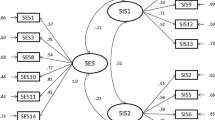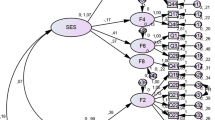Abstract
The purpose of the current investigation was to develop a scale that would assess propensity for sexual arousal in response to a broad range of stimuli and sexual situations in both men and women. In Study 1, data from a nonclinical sample of 481 male and female students (graduate and undergraduate) were submitted to exploratory and confirmatory factor analyses in order to develop the Sexual Excitation/Sexual Inhibition Inventory for Women and Men (SESII-W/M), and gender differences on the subscales were tested. In Study 2, construct validity and test–retest reliability of the SESII-W/M were assessed with a second sample of undergraduate students. The resultant measurement tool was comprised of six subscales: Inhibitory Cognitions, Relationship Importance, Arousability, Partner Characteristics and Behaviors, Setting (Unusual or Unconcealed), and Dyadic Elements of the Sexual Interaction. The measure demonstrated good test–retest reliability and discriminant and convergent validity. The SESII-W/M will likely be a useful measure in investigations in which sexual inhibition and sexual excitation must be assessed identically for men and women.

Similar content being viewed by others
References
Arbuckle, J. L. (2006). Amos 7.0 [Computer software]. Chicago, IL: Smallwaters.
Baer, A., Saroiu, S., & Koutsky, L. A. (2002). Obtaining sensitive data through the Web: An example of design and methods. Epidemiology, 13, 640–645.
Bancroft, J. (1999). Central inhibition of sexual response in the male: A theoretical perspective. Neuroscience and Biobehavioral Reviews, 23, 763–784.
Bancroft, J., Carnes, J., Janssen, E., & Long, J. S. (2005). Erectile and ejaculatory problems in gay and heterosexual men. Archives of Sexual Behavior, 34, 285–297.
Bancroft, J., Graham, C. A., Janssen, E., & Sanders, S. A. (2009). The dual control model: Current status and future directions. Journal of Sex Research, 46, 121–142.
Bancroft, J., Herbenick, D., Barnes, T., Hallam-Jones, R., Wylie, K., Janssen, E., et al. (2005). The relevance of the dual control model to male sexual dysfunction: The Kinsey Institute/BASRT Collaborative Project. Sexual and Relationship Therapy, 20, 13–30.
Bancroft, J., & Janssen, E. (2000). The dual control model of male sexual response: A theoretical approach to centrally mediated erectile dysfunction. Neuroscience and Biobehavioral Reviews, 24, 571–579.
Bancroft, J., Janssen, E., Carnes, L., Goodrich, D., Strong, D., & Long, J. S. (2004). Sexual activity and risk taking in young heterosexual men: The relevance of sexual arousability, mood, and sensation seeking. Journal of Sex Research, 41, 181–192.
Bancroft, J., Janssen, E., Strong, D., Vukadinovic, Z., & Long, J. S. (2003). The relation between mood and sexuality in heterosexual men. Archives of Sexual Behavior, 32, 217–230.
Basson, R. (2000). The female sexual response: A different model. Journal of Sex and Marital Therapy, 26, 51–65.
Basson, R. (2001). Human sex-response cycles. Journal of Sex and Marital Therapy, 27, 33–43.
Baumeister, R. F., Catanese, K. R., & Vohs, K. D. (2001). Is there a gender difference in the strength of sex drive? Theoretical views, conceptual distinctions, and a review of relevant evidence. Personality and Social Psychology Review, 5, 242–273.
Bentler, P. M. (1990). Fit indices, LaGrange multipliers, constraint changes, and incomplete data in structural models. Multivariate Behavioral Research, 25, 163–172.
Bentler, P. M., & Bonnett, D. G. (1980). Significance tests and goodness-of-fit in the analysis of covariance structures. Psychological Bulletin, 88, 588–600.
Bjorklund, D. F., & Kipp, K. (1996). Parental investment theory and gender differences in the evolution of inhibition mechanisms. Psychological Bulletin, 120, 163–188.
Bollen, K. A. (1989). Structural equations with latent variables. New York: John Wiley.
Brezsnyak, M., & Whisman, M. A. (2004). Sexual desire and relationship functioning: The effects of marital satisfaction and power. Journal of Sex and Marital Therapy, 30, 199–217.
Buss, D. M., & Schmitt, D. P. (1993). Sexual strategies theory: An evolutionary perspective on human mating. Psychological Review, 100, 204–232.
Byers, E. S. (2001). Evidence for the importance of relationship satisfaction for women’s sexual functioning. Women and Therapy, 24, 23–26.
Carpenter, D. L., Janssen, E., Graham, C. A., Vorst, H., & Wicherts, J. (2008). Women’s scores on the Sexual Inhibition/Sexual Excitation Scales (SIS/SES): Gender similarities and differences. Journal of Sex Research, 45, 36–48.
Carver, C. S., & White, T. L. (1994). Behavioral inhibition, behavioral activation, and affective responses to impending reward and punishment: The BIS/BAS Scales. Journal of Personality and Social Psychology, 67, 319–333.
Comrey, A. L., & Lee, H. B. (1992). A first course in factor analysis (2nd ed.). Hillsdale, NJ: Lawrence Erlbaum Associates.
Daker-White, G. (2002). Reliable and valid self-report outcome measures in sexual (dys)function: A systematic review. Archives of Sexual Behavior, 31, 197–209.
Davidson, J. K. (1985). The utilization of sexual fantasies by sexually experienced university students. Journal of American College Health, 34, 24–32.
Dennerstein, L., Lehert, P., & Burger, H. (2005). The relative effects of hormones and relationship factors on sexual function of women through the natural menopausal transition. Fertility and Sterility, 84, 174–180.
Ellison, C. R. (2001). A research inquiry into some American women’s sexual concerns and problems. Women and Therapy, 24, 147–159.
Fisher, W., Byrne, D., White, L. A., & Kelley, K. (1988). Erotophobia-erotophilia as a dimension of personality. Journal of Sex Research, 25, 123–151.
Gaither, G. A., & Sellbom, M. (2003). The Sexual Sensation Seeking Scale: Reliability and validity within a heterosexual college student sample. Journal of Personality Assessment, 81, 157–167.
Gerressu, M., Mercer, C. H., Graham, C. A., Wellings, K., & Johnson, A. M. (2008). British national probability data on masturbation prevalence and associated factors. Archives of Sexual Behavior, 37, 266–278.
Graham, C. A., Sanders, S., Milhausen, R. R., & McBride, K. (2003, November). Factors related to inhibition and excitation of sexual arousal in women. Paper presented at the meeting of the Society for the Scientific Study of Sexuality, Montreal, Quebec.
Graham, C. A., Sanders, S. A., & Milhausen, R. R. (2006). The Sexual Excitation and Sexual Inhibition Inventory for Women: Psychometric properties. Archives of Sexual Behavior, 35, 397–410.
Graham, C. A., Sanders, S. A., Milhausen, R. R., & McBride, K. R. (2004). Turning on and turning off: A focus group study of the factors that affect women’s sexual arousal. Archives of Sexual Behavior, 33, 527–538.
Hartman, L. M. (1985). Attentional focus, sexual responding, and meta-cognitions. Journal of Sex Research, 21, 211–217.
Hayes, R. D., Dennerstein, L., Bennett, C., & Fairley, C. (2008). What is the “true” prevalence of female sexual dysfunctions and does the way we assess these conditions have an impact? Journal of Sexual Medicine, 5, 777–787.
Hays, R. D., Hayashi, T., & Stewart, A. L. (1989). A five-item measure of socially desirable response set. Educational and Psychological Measurement, 49, 629–636.
Huck, S. W. (2000). Reading statistics and research (3rd ed.). Boston: Allyn & Bacon.
Hyde, J. S. (2005). The gender similarities hypothesis. American Psychologist, 60, 581–592.
Janssen, E., Everaerd, W., Spiering, M., & Janssen, J. (2000). Automatic processes and the appraisal of sexual stimuli: Toward an information processing model of sexual arousal. Journal of Sex Research, 37, 8–23.
Janssen, E., McBride, K. R., Yarber, W., Hill, B. J., & Butler, S. M. (2007). Factors that influence sexual arousal in men: A focus group study. Archives of Sexual Behavior, 37, 252–265.
Janssen, E., Vorst, H., Finn, P., & Bancroft, J. (2002a). The Sexual Inhibition (SIS) and Sexual Excitation (SES) Scales: I. Measuring sexual inhibition and excitation proneness in men. Journal of Sex Research, 39, 114–126.
Janssen, E., Vorst, H., Finn, P., & Bancroft, J. (2002b). The Sexual Inhibition (SIS) and Sexual Excitation (SES) Scales: II. Predicting psychophysiological response patterns. Journal of Sex Research, 39, 127–132.
Jöreskog, K. G., & Sörbom, D. (1987). LISREL 7. A guide to the program and applications. Chicago: SPSS.
Kalichman, S. C., & Rompa, D. (1995). Sexual Sensation Seeking and Sexual Compulsivity scales: Reliability, validity, and predicting HIV risk behavior. Journal of Personality Assessment, 65, 586–601.
Kaplan, H. S. (1979). Disorders of desire. New York: Brunner/Mazel.
Kaplowitz, M. D., Hadlock, T. D., & Levine, R. (2004). A comparison of web and mail survey response rates. Public Opinion Quarterly, 68, 94–101.
Leitenberg, H., & Henning, K. (1995). Sexual fantasy. Psychological Bulletin, 117, 469–496.
Lykins, A. D., Janssen, E., & Graham, C. A. (2006). The relationship between negative mood and sexuality in heterosexual college women and men. Journal of Sex Research, 43, 136–143.
Masters, W. H., & Johnson, V. E. (1966). Human sexual response. London, England: Churchill.
McCabe, M. P. (1997). Intimacy and quality of life among sexually dysfunctional males and females. Journal of Sex and Marital Therapy, 23, 276–290.
Mustanski, B. S. (2001). Getting wired: Exploiting the Internet for the collection of valid sexuality data. Journal of Sex Research, 38, 292–302.
Pealer, L. N., Weiler, R. M., Pigg, R. M., Miller, D., & Dorman, S. M. (2001). The feasibility of a web-based surveillance system to collect health risk behavior data from college students. Health Education and Behavior, 28, 547–559.
Sanders, S. A., Graham, C. A., & Milhausen, R. R. (2008). Predicting sexual problems in women: The relevance of sexual excitation and sexual inhibition. Archives of Sexual Behavior, 37, 241–251.
Sax, L. J., Gilmartin, S. K., & Bryant, A. N. (2003). Assessing response rates and nonresponse bias in web and paper surveys. Research in Higher Education, 44, 409–432.
Steiger, J. H. (1990). Structural model evaluation and modification: An interval estimation approach. Multivariate Behavioral Research, 25, 173–180.
Tabachnick, B. G., & Fidell, L. S. (2007). Using multivariate statistics (5th ed.). Boston: Allyn & Bacon.
The Working Group for a New View of Women’s Sexual Problems. (2001). A new view of women’s sexual problems. Women and Therapy, 24, 1–8.
Tolman, D. L. (2001). Female adolescent sexuality: An argument for the developmental perspective on the New View of Women’s Sexual Problems. Women and Therapy, 24, 195–210.
Witting, K., Santtila, P., Varjonen, M., Jern, P., Johansson, A., von der Pahlen, B., et al. (2008). Female sexual dysfunction, sexual distress, and compatibility with partner. Journal of Sexual Medicine, 5, 2587–2599.
Worthen, B. R., White, K. R., Fan, X., & Sudweeks, R. R. (1999). Measurement and assessment in schools (2nd ed.). New York: Longman.
Author information
Authors and Affiliations
Corresponding author
Rights and permissions
About this article
Cite this article
Milhausen, R.R., Graham, C.A., Sanders, S.A. et al. Validation of the Sexual Excitation/Sexual Inhibition Inventory for Women and Men. Arch Sex Behav 39, 1091–1104 (2010). https://doi.org/10.1007/s10508-009-9554-y
Received:
Revised:
Accepted:
Published:
Issue Date:
DOI: https://doi.org/10.1007/s10508-009-9554-y




